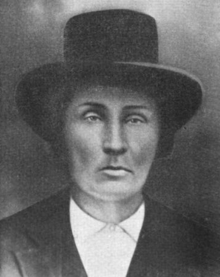Charles Thompson (Cherokee chief)
Charles Thompson | |
|---|---|
 | |
| Born | Utselata, ᎤᏤᎳᏔ, in Cherokee[1] Unknown Southeastern United States |
| Died | June 22, 1891 Delaware District, Cherokee Nation, Oklahoma |
| Nationality | Cherokee |
| Other names | Charles Thompson |
| Occupation(s) | Farmer, Lawyer, |
| Known for | Principal Chief of the Cherokee Nation |
Charles Thompson (Utselata,
Education
Utselata, as he was called until later in life, attended the Baptist Mission School, where he was strongly influenced by the Reverend Evan Jones and John B. Jones. He joined the Baptist church during this time.[3] Utselata joined the Keetoowah Society in 1859, when it was founded by John B. Jones. The abolition of slavery was one of the society's principles.[2]
Civil War military service
He enlisted in Drew's 1st Cherokee Mounted Rifles, a Confederate unit commanded by Colonel John Drew. He rescinded his enlistment and joined the Third Indian Home Guards as a corporal on July 11, 1862. This unit, commanded by Lieutenant Colonel Lewis Downing, served with the Union Army. Utselata continued to serve through the rest of the war.[2]
Post-war life
At the end of the Civil War, Utselata moved to a place on Spavinaw Creek, near the present-day town of Eucha, Oklahoma, where he established a farm. He occasionally practiced law before the tribal courts.[2]
In 1867 he was elected to the Senate of the
He was a Baptist deacon, preaching each Sunday at the church in Eucha in the Cherokee language. The church denied him ordination as a minister because of a policy that prevented lawyers from becoming ordained ministers. This alleged disqualification was waived when he became principal chief.[2]
Death and burials
Charles Thompson died June 22, 1891, and was buried in the Indian cemetery at Eucha.[2] The town of Eucha, including the cemetery, was relocated before Lake Eucha was completed in 1952. He was reburied just inside the new cemetery. A military stone at the grave honors his service to the Union during the Civil War.[4]
Sources
McLoughlin, William G. After the Trail of Tears: The Cherokees' Struggle for Sovereignty 1839-1880. 1993. University of North Carolina Press. Chapel Hill.
References
- ^ a b "Charles Thompson". Cherokee Nation. Retrieved 30 June 2017.
- ^ a b c d e f g Meserve, John B. "Chief Lewis Downing and Chief Charles Thompson (Oochalata.)" Chronicles of Oklahoma. Vol. 16, No. 3 September 1938. Retrieved July 17, 2013. Archived 29 October 2013 at the Wayback Machine
- ^ Conley, Robert. A Cherokee Encyclopedia. University of New Mexico Press. Available on Google Books. Retrieved July 17, 2013.
- ^ Rose Stauber, "Delaware County." Encyclopedia of Oklahoma History and Culture. Retrieved September 19, 2013.
